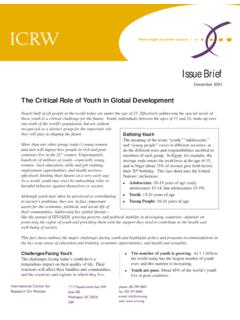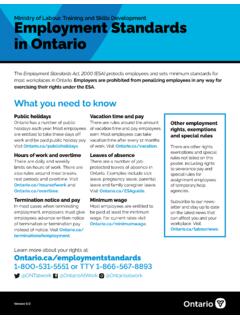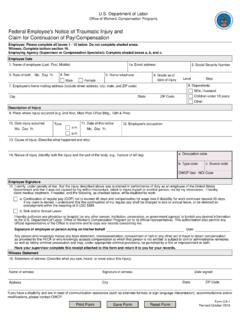Transcription of Everything You Need to Know about the Equal Pay Act
1 1 Everything You Need to Know about the Equal Pay Act Developed by: Rosa Cho, Researcher & Writer Abagail Kramer, Intern Researcher Introduction Known for feisty quotes and progressive politics well ahead of her time, Rep. Bella Abzug (D-NY) initiated a bill to commemorate the day the Nineteenth Amendment, which guarantees women the right to vote, became law. The Congress declared August 26th Women s Equality Day in 1971. Eight years prior, the Equal Pay Act was signed by President Kennedy with the intention of ending gender-based pay discrimination. Together, Women s Equality Day and the Equal Pay Act signaled an important step forward in the nation s commitment to women exercising their right to participate meaningfully in civil and political affairs and become thriving citizens in socioeconomic spheres. And yet 40 years later, women are still robbed of 23 cents for every dollar a man makes in the Even with the passage of five groundbreaking laws to prevent discrimination in the workplace , the Civil Rights Act and the Fair Labor Standards Act the gender pay gap is still an intractable problem.
2 This primer explores the historical, legal and legislative background of gender and pay discrimination issues in the using a gender lens. It looks at how the pay gap relates to larger ideas about ourselves as workers and the forces at play in work-life issues. Finally, it presents prominent sociological arguments for why the pay gap exists and persists, as well as best practices from peer nations that are worthy of consideration in a context. 1. What is the Equal Pay Act? In short, the Equal Pay Act (EPA) prohibits pay discrimination based on sex and states that men and women must be paid equally for substantially Equal work performed in the same establishment. All forms of compensation are included salary, bonuses, vacation and holiday pay, and other benefits, to name a few. The Act also allows individuals to file for pay discrimination claims under Title VII of the Civil Rights Act. Employers are legally prohibited from retaliating against employees who take action against discriminatory practices in the What is the Equal Rights Amendment?
3 Equality of rights under the law shall not be denied or abridged by the United States or any State on account of sex these words are what lies in the heart of the Equal Rights Amendment (ERA). In 1923, Alice Paul, a women s rights activist whose suffragist campaign culminated in passage of the Nineteenth Amendment, wrote the ERA. Congress passed the amendment in 1972 and sent it on to the states for ratification. In 1982, it came closest to being ratified when thirty-five of the thirty-eight states required for inclusion in the Constitution passed it. The amendment has been reintroduced into (and defeated by) every Congress since then. In the 113th Congress (2013 2015), the ERA was reintroduced as Res 56 by Rep. Carolyn Maloney (D-NY), who continues to call for the prohibition of denying or abridging Equal rights under law by the United States or any state on account of sex as it was originally proposed in 1923. Everything You Need to Know about the Equal Pay Act 2 workplace.
4 However, the law allows for pay differentials when individuals are evaluated based on criteria such as seniority, production levels, and merit. Administered and enforced by the Equal Employment Opportunity Commission (EEOC), the EPA was signed into law in 1963 as part of the Fair Labor Standards Act of 1938. Its employee protections and prohibitions against discrimination align it with other federal laws such as Title VII of the Civil Rights Act of 1964, the Age Discrimination in Employment Act (ADEA) of 1967, and Title I of the Americans with Disabilities Act (ADA) of 1990. 2. History & timeline Although many women women of color, immigrant women and poor and working class women, to name a few have worked outside the home or been paid for their labor since the country s beginning, the world of paid work has primarily existed as part of men s public sphere in the American psyche. Up until WWII when unprecedented numbers of women entered the workforce, women were expected to exist in the private sphere, performing unpaid work.
5 Recognizing that women largely replaced male workers in war labor industry, the National War Labor Board in 1942 encouraged industry leaders to make adjustments which [would] equalize wage or salary rates paid to females with the rates paid to males for comparable quality and quantity of work on the same or similar operation. More and more women entered the world of paid labor thereafter, and pay discrimination based on sex remained rampant and blatant. Women made 59% of what men earned in 1963. In the early 1960s, job advertisements were listed by sex. Not surprisingly, most high-salary positions were allocated to men, and even when the same position was advertised to both sexes, a two-tiered scale ensured male candidates would be paid more than their female counterparts. Rep. Winifred Stanley (R-NY) proposed the first bill to amend the National Labor Relations Act to end gender wage discrimination in 1944, but the bill expired after it was referred to the Committee on Labor. In 1950, Rep.
6 Katharine St. George (R-NY), renowned for coining the phrase Equal pay for Equal work, negotiated a compromise bill that would also permit the passage of the Equal Rights Amendment. This bill also failed. Ever persistent, St. George proposed a work bill in 1959 that called for Equal pay for comparable work. It stalled for considerable time because of debates over the definition of comparable. As St. George remarked in an oral history interview: I always women were discriminated against in I think women are quite capable of holding their own if they re given the opportunity. What I wanted them to have was the opportunity. The bill s language held up and ultimately became part of the EPA. On June 10, 1963, President John F. Kennedy signed the Equal Pay Act, and the law took effect on June 11, 1964 as part of Kennedy s New Frontier Program. TIMELINE Date Status Legislation December 10, 1923 First introduced Equal Rights Amendment: Equality of rights under the law shall not be denied or abridged by the United States or any State on account of sex these words are the heart of the Equal Rights Amendment (ERA).
7 In 1923, Alice Paul, a women s rights activist whose suffragist campaign culminated in passage of the Nineteenth Amendment, wrote the ERA. Congress passed the amendment in 1972 and sent it on to the states for ratification. In 1982, it came closest to being ratified when thirty-five of the thirty-eight states required for inclusion in the Constitution passed it. The amendment has been reintroduced into (and defeated by) every Congress since then. In the 113th Congress (2013 2015), the ERA was August 1, 2013 Reintroduced Everything You Need to Know about the Equal Pay Act 3 reintroduced as Res 56 by Rep. Carolyn Maloney (D-NY), who continues to call for the prohibition of denying or abridging Equal rights under law by the United States or any State on account of sex as it was originally proposed in 1923. June 25, 1938 Enacted Fair Labor Standards Act: On June 25, 1938, the Fair Labor Standards Act (FLSA) was signed into law by President Franklin D. Roosevelt. Designed to eliminate labor conditions detrimental to the maintenance of the minimum standards of living necessary for health, efficiency, and general well-being of workers, the FLSA was the last piece of New Deal legislation passed.
8 It establishes minimum wage, overtime pay, recordkeeping and child labor standards. The law impacts full-time and part-time workers of both private and Federal, State and local government sectors. It is administered and enforced by the Wage and Hour Division of the Department of Labor. June 10, 1963 Enacted Equal Pay Act: On June 10, 1963, President Kennedy signed the Equal Pay Act, as part of the Fair Labor Standards Act, into law. The EPA prohibits sex-based wage discrimination between men and women in the same establishment who perform jobs that require substantially Equal skill, effort and responsibility under similar working conditions. Administered and enforced by the Equal Employment Opportunity Commission (EEOC), the EPA attempts to fulfill the aspiration of Equal pay for Equal work and reduce the gender pay gap. July 2, 1964 Enacted Title VII of the Civil Rights Act: On July, 2, 1964, the Civil Rights Act, originally proposed by President John F. Kennedy, was signed into law by President Lyndon B.
9 Johnson. Enforced by the Equal Employment Opportunity Commission (EEOC), Title VII of the Civil Rights Act of 1964 prohibits employment discrimination based on color, race, sex, religion and national origin in workplaces having more than 15 employees, including local, State and Federal government offices, employment agencies and labor organizations. The law covers job applications, hiring procedures, job training and terms, conditions, and privileges of employment. It prohibits employment decisions based on stereotypes and other discriminatory practices not only intentional discrimination but also neutral employment policies that have disproportionately negative or disparate impact on individuals of certain racial/ethnic groups. December 15, 1967 Enacted Age Discrimination in Employment Act (ADEA): On December 15, 1967, the Age Discrimination in Employment Act (ADEA) was signed into law by President Lyndon B. Johnson. The ADEA prohibits employment discrimination against workers 40-years old or older and affects various employment-related issues, ranging from job application, hiring procedures, job training to terms, conditions, and privileges of employment, etc.
10 Enforced by the Equal Employment Opportunity Commission (EEOC), the law applies to employers with 20 or more employees and to federal government, interstate agencies, employment agencies and labor unions. Everything You Need to Know about the Equal Pay Act 4 June 23, 1972 Enacted Title IX of the Education Amendments: On June 23, 1972, Title IX of the Education Amendments was signed into law by President Richard Nixon and it added strength to the women s rights movement. Commonly known for prohibiting sex discrimination in athletic activities in schools, Title IX applies to other areas of education that receive federal funding, including higher education, career education, programs related to standardized testing and employment, etc. July 26, 1990 Enacted Title I of the Americans with Disabilities Act (ADA): On July 26, 1990, the Americans with Disabilities Act (ADA) was signed into law by President George H. W. Bush. The ADA prohibits discrimination based on disability, and specifically, Title I of the ADA prohibits a range of employment-related discriminatory issues, ranging from job application, hiring procedures, job training to terms and conditions of employment, etc.
















